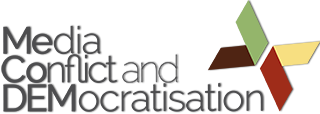Empirical findings from interviews with journalists reporting on democratisation conflicts and discussing structural working conditions of journalism in Egypt, Kenya, Serbia and South Africa by Judith Lohner, Irene Neverla and Sandra Banjac are now available!
Download at: http://www.mecodem.eu/publications/working-papers
Executive Summary
This report provides an overview of core comparative findings from MeCoDEM interviews with journalists in Egypt, Kenya, Serbia and South Africa. It investigates the structural working conditions of journalistic actors in transitional societies across a set of comparable democratisation conflicts. Empirically, the study builds on qualitative semi-structured face-to face in-depth interviews with 100 professional journalists working for local news organisations in the four countries. Interviews employed the reconstruction method.
- The analysis confirms that journalism faces highly complex, ambivalent, contradictory and changing structural conditions in all MeCoDEM countries.
- The structural conditions of journalism are shaped by legacies of the past (marked by non-democratic regimes and sometimes colonial rule) and persisting power structures. The state and powerful political actors are perceived to play an important role in the media sector, mirrored in different forms of political interference directed at newsrooms and individual journalists in the way of repressive legal frameworks, political ownership and advertising, economic censorship and blackmail, as well as threats directed at the physical and psychological safety of journalists. Journalists perceive the relationship between different communities in society to be reflected in the constitution of and atmosphere among newsroom staff.
- Even though journalists operate in a more liberal environment than under autocratic rule in Kenya, Serbia and South Africa, media privatisation has created new dependencies and pressures: Against the background of profit-making pressures in capitalist and highly commercialised media markets, journalists claim to work under precarious working conditions, marked by time constraints due to short-staffed newsroom and juniorisation, high professional insecurity and poor salaries arguably making journalists vulnerable to bribery and corruption. Challenges relating to journalistic professionalism also translate into insufficient training on conflict-sensitive reporting and safety measures for journalists reporting on conflicts, low professional organisation and self-regulation, as well as a lack of professional solidarity and prestige.
- The salience of different elements of structural constraints varies depending on the stages of transition and consolidation which imply different degrees of democratisation relating to media structures. These become evident, for example, in differing levels of legal and practical media freedom, state interference in the newsrooms and the nature of threats against journalists.
- Also, the nature and salience of structural constraints depends on the conflict context: Violent protests (such as the service delivery protests in South Africa or the Pride Parade in Serbia) become a challenge especially for the physical and psychological safety of reporters working on the ground. Predominantly political conflicts (such as election campaigns) enhance various forms of overt and subtle political interference in the newsrooms and pressures against individual (mainly senior) journalists.
